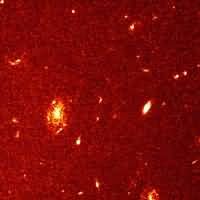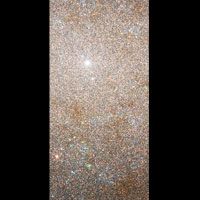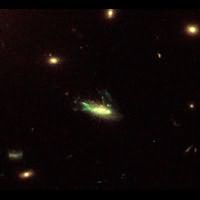Hubble’s Ugliest Photographs
/https://tf-cmsv2-smithsonianmag-media.s3.amazonaws.com/filer/20110520104105browndwarf.jpg)
With the Hubble Space Telescope’s fifth—and final—repair mission underway, Smithsonian.com highlighted the finest photographs taken by the world’s most famous telescope. While Hubble has plenty of hits, not all of its more than 200,000 pictures can be compared to Vincent Van Gogh’s “Starry Night.” The images below may not be breathtaking, but to astronomers the beauty is in the science.
#1) See The Brown Dwarfs?
This pixilated blob may look like a video game power-up, but it’s actually rare evidence of brown dwarfs (there are two in the picture, can’t you tell?) in the neighborhood of a sun-like star. Only two out of 233 star systems observed by Georgia State University astronomers had resident brown dwarfs, gas bodies that are larger than planets but not quite massive enough to sustain fusion reactions, as stars do.

#2) The Small Bang
Galaxy GRB 971214 doesn’t look like the friendliest neighborhood. In 1998, it generated the most energetic burst known, several times more powerful than an exploding star. The cause of the blast has yet to be determined, but scientists at the California Institute of Technology are studying the afterglow to learn about the consequences of these kinds of events.

#3) In The Shadows
Scientists can block out the sun! Astronomers captured the dim glow of the planet HR 8799b (see lower right corner of picture) by using a filter that removes the starlight of the planet's sun. As of last month, 347 planets outside our solar system have been found. An October 2006 Smithsonian magazine article explained why it’s only a matter of time before we find another Earth.

#4) Turn Off Your Flash
This photograph might look a bit overexposed, but that’s part of the challenge of capturing millions of stars on film. This is one of the images produced during a survey of nearby galaxies, which covered roughly 14 million stars in 69 galaxies. The details in these pictures—the number of stars, types of stars and their colors—are helping scientists learn the unique characteristics of each galaxy.

#5) Fatal Plunge
The greenish-yellow blotch in the center of this photograph, a galaxy called C153, is disappearing. It is zooming 4.5 million miles per hour through hot gas that is stripping it of the materials necessary to make new stars. Astronomers studying C153’s quick and violent death are looking for clues to explain why spiral galaxies, which were abundant in the early days of the universe, are much less common today.
--Joseph Caputo
(Image credits: brown dwarfs: NASA, ESA, and M. Stumpf (MPIA); gamma-ray burst: S. R. Kulkarni and S. G. Djorgovski (Caltech), the Caltech GRB Team and NASA; exoplanet: NASA, ESA, and D. Lafrenière (University of Toronto, Canada); millions of stars: NASA, ESA, J. Dalcanton and B. Williams (University of Washington); and galaxy C153: F. Owen (NRAO), W. Keel (U. AL), M. Ledlow (Gemini Obs.), G. Morrison (UNM), V. Andersen (U. AL))
/https://tf-cmsv2-smithsonianmag-media.s3.amazonaws.com/accounts/headshot/Sarah-Zielinski-240.jpg)
/https://tf-cmsv2-smithsonianmag-media.s3.amazonaws.com/accounts/headshot/Sarah-Zielinski-240.jpg)